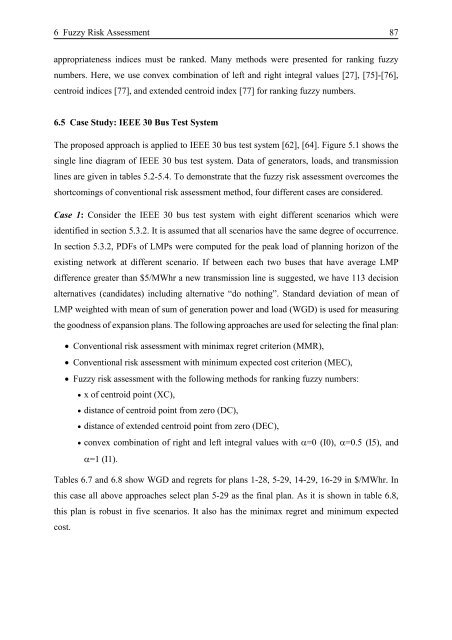Transmission Expansion Planning in Deregulated Power ... - tuprints
Transmission Expansion Planning in Deregulated Power ... - tuprints
Transmission Expansion Planning in Deregulated Power ... - tuprints
You also want an ePaper? Increase the reach of your titles
YUMPU automatically turns print PDFs into web optimized ePapers that Google loves.
6 Fuzzy Risk Assessment 87<br />
appropriateness <strong>in</strong>dices must be ranked. Many methods were presented for rank<strong>in</strong>g fuzzy<br />
numbers. Here, we use convex comb<strong>in</strong>ation of left and right <strong>in</strong>tegral values [27], [75]-[76],<br />
centroid <strong>in</strong>dices [77], and extended centroid <strong>in</strong>dex [77] for rank<strong>in</strong>g fuzzy numbers.<br />
6.5 Case Study: IEEE 30 Bus Test System<br />
The proposed approach is applied to IEEE 30 bus test system [62], [64]. Figure 5.1 shows the<br />
s<strong>in</strong>gle l<strong>in</strong>e diagram of IEEE 30 bus test system. Data of generators, loads, and transmission<br />
l<strong>in</strong>es are given <strong>in</strong> tables 5.2-5.4. To demonstrate that the fuzzy risk assessment overcomes the<br />
shortcom<strong>in</strong>gs of conventional risk assessment method, four different cases are considered.<br />
Case 1: Consider the IEEE 30 bus test system with eight different scenarios which were<br />
identified <strong>in</strong> section 5.3.2. It is assumed that all scenarios have the same degree of occurrence.<br />
In section 5.3.2, PDFs of LMPs were computed for the peak load of plann<strong>in</strong>g horizon of the<br />
exist<strong>in</strong>g network at different scenario. If between each two buses that have average LMP<br />
difference greater than $5/MWhr a new transmission l<strong>in</strong>e is suggested, we have 113 decision<br />
alternatives (candidates) <strong>in</strong>clud<strong>in</strong>g alternative “do noth<strong>in</strong>g”. Standard deviation of mean of<br />
LMP weighted with mean of sum of generation power and load (WGD) is used for measur<strong>in</strong>g<br />
the goodness of expansion plans. The follow<strong>in</strong>g approaches are used for select<strong>in</strong>g the f<strong>in</strong>al plan:<br />
• Conventional risk assessment with m<strong>in</strong>imax regret criterion (MMR),<br />
• Conventional risk assessment with m<strong>in</strong>imum expected cost criterion (MEC),<br />
• Fuzzy risk assessment with the follow<strong>in</strong>g methods for rank<strong>in</strong>g fuzzy numbers:<br />
• x of centroid po<strong>in</strong>t (XC),<br />
• distance of centroid po<strong>in</strong>t from zero (DC),<br />
• distance of extended centroid po<strong>in</strong>t from zero (DEC),<br />
• convex comb<strong>in</strong>ation of right and left <strong>in</strong>tegral values with α=0 (I0), α=0.5 (I5), and<br />
α=1 (I1).<br />
Tables 6.7 and 6.8 show WGD and regrets for plans 1-28, 5-29, 14-29, 16-29 <strong>in</strong> $/MWhr. In<br />
this case all above approaches select plan 5-29 as the f<strong>in</strong>al plan. As it is shown <strong>in</strong> table 6.8,<br />
this plan is robust <strong>in</strong> five scenarios. It also has the m<strong>in</strong>imax regret and m<strong>in</strong>imum expected<br />
cost.

















